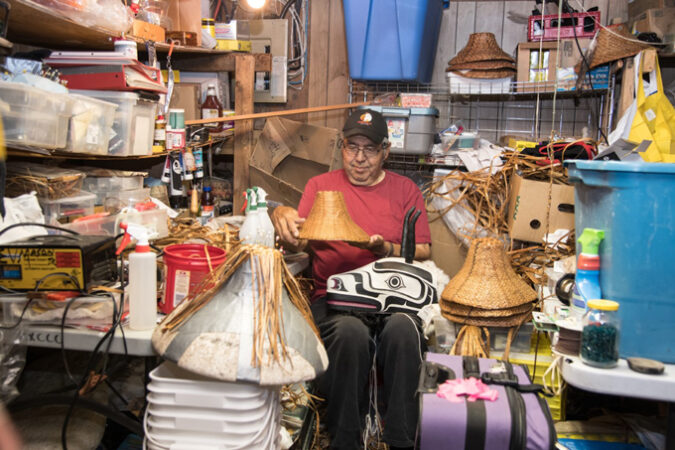For thousands of years, members of the Kitasoo/Xai’xais First Nation in Canada have prized the mountain goats that roam the craggy peaks of British Columbia’s central coast.
The animals have long been an important food source, explains Kitasoo/Xai’xais Chief Councillor Doug Neasloss. And “we use the mountain goat in a lot of our cultural events — songs and dances and stories.”
Formerly a wildlife tour guide, Neasloss remembers seeing lots of the goats in the region in past decades, but no longer. And many in the community have noticed a similar trend.
Goats in Kitasoo/Xai’xais territory are thought to occur at lower densities than farther east in the goats’ range in the higher Rocky Mountains. But there has been “almost zero research” on British Columbia’s coastal mountain goats (Oreamnos americanus), until now, says Tyler Jessen, a conservation biologist at the University of Victoria in Canada.
Kitasoo/Xai’xais community members partnered with Jessen and his colleagues to investigate the mountain goats’ status. Numbers of the animals do seem to have undergone a decline since the 1980s, the team reports March 8 in Conservation Science and Practice. The reasons why remain unknown but might be a result of a warming climate, the researchers say.
To estimate contemporary goat numbers and density, the researchers conducted aerial surveys in 2019 and 2020, scrutinizing habitats higher than 1,000 meters above sea level in Kitasoo/Xai’xais territory near Klemtu, British Columbia. To estimate how goat numbers have changed over time, the research team interviewed individuals from the local community who regularly hunt wildlife, guide, conduct research or fish the region. For each decade back to the 1980s, participants gave estimates for how many days out of 10 they saw goats.
 Kitasoo/Xai’xais First Nation’s Hereditary Chief Ernest V. Mason, also known by his hereditary chief name Hay-mass, holds a carved mountain goat mask. The animals have long played an important role in the Indigenous group’s culture.Shanna Baker/Hakai Magazine
Kitasoo/Xai’xais First Nation’s Hereditary Chief Ernest V. Mason, also known by his hereditary chief name Hay-mass, holds a carved mountain goat mask. The animals have long played an important role in the Indigenous group’s culture.Shanna Baker/Hakai Magazine
Finally, to draw inferences about goat trends over a broader geographic scale, the researchers analyzed mountain goat hunting data across British Columbia from 1980 to 2018.
“One of the biggest challenges we have in science, especially with population trends, is that knowledge is primarily based on the length of the study, which can be extremely limited,” says Elizabeth Flesch, a wildlife geneticist at Montana State University in Bozeman who was not involved in the study.
That’s especially true for species tricky to count in remote, rugged habitats, like mountain goats, she says. Flesch commended the triad of independent methods that the researchers used to tackle that challenge.
The helicopter surveys tallied 0.25 goats per square kilometer, a low-density population. Interviews revealed that “the number of sightings of mountain goats has declined hugely since the 1980s,” says Jessen, when some Kitasoo/Xai’xais people reported seeing goats six days out of 10. That compares with 2019, “when nobody [who was interviewed] saw any goats,” Jessen says.
Hunting data obtained from the government of British Columbia revealed that success rates of nonresident hunters killing goats with the help of professional guides increased from the 1980s to 1990s in coastal regions all across British Columbia, and then remained relatively constant. In contrast, kills per days spent hunting have slowly and steadily declined throughout the province for resident hunters, who do not use professional guides, paralleling the Kitasoo/Xai’xais community members’ sense of declining goat numbers more locally.
Still, Jessen cautions, the analyses cannot distinguish population declines from shifts in distribution, meaning the coastal goats on Kitasoo/Xai’xais territory may have just relocated elsewhere, or relocated and declined. If the goat numbers are declining, the potential reasons are yet unknown, but being at low density, Jessen says, makes the goats especially vulnerable to any stressors.
The team suspects that climate change may be playing a role, though more research is needed. Christina Service, a wildlife biologist with the Kitasoo/Xai’xais First Nation Stewardship Authority, says during the summer of 2019, high temperatures meant “near heatstroke for humans” hiking at those high elevations.

Sign Up For the Latest from Science News
Headlines and summaries of the latest Science News articles, delivered to your inbox
Client key* E-mail Address* Go
Thank you for signing up!
There was a problem signing you up.
“In hot temperatures, mountain goats can be thermally stressed,” says wildlife biologist Kevin White, formerly with the Alaska Department of Fish and Game. His long-term work in coastal Alaska following GPS-collared goats suggests that hot summers decrease mountain goat winter survival. But goat survival can also depend on predation, industrial disturbances and tourism, among other factors, says White, who wasn’t involved in the new study.
Kitasoo/Xai’xais members have voluntarily halted goat hunting in their territory over the last two decades to avoid endangering the goats. The group is also urging provincial authorities in British Columbia to take local knowledge into account, and suspend provincially sanctioned nonresident hunting in territories like theirs where goat numbers appear low.
Though focused on mountain goats, the study’s methods could shed light on any poorly understood wildlife population, Service says (SN: 11/11/19) “There are lots of areas of the world where we don’t have long-term baseline information, and where there are really rich local knowledge sources.”
It’s a case study of what can happen, she says, “when you harness the power of different ways of knowing.”

